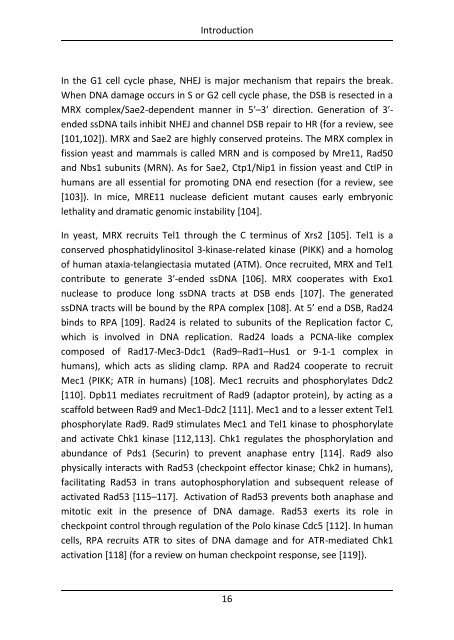View/Open - Università degli Studi di Milano-Bicocca
View/Open - Università degli Studi di Milano-Bicocca
View/Open - Università degli Studi di Milano-Bicocca
You also want an ePaper? Increase the reach of your titles
YUMPU automatically turns print PDFs into web optimized ePapers that Google loves.
Introduction<br />
In the G1 cell cycle phase, NHEJ is major mechanism that repairs the break.<br />
When DNA damage occurs in S or G2 cell cycle phase, the DSB is resected in a<br />
MRX complex/Sae2-dependent manner in 5′–3′ <strong>di</strong>rection. Generation of 3′ended<br />
ssDNA tails inhibit NHEJ and channel DSB repair to HR (for a review, see<br />
[101,102]). MRX and Sae2 are highly conserved proteins. The MRX complex in<br />
fission yeast and mammals is called MRN and is composed by Mre11, Rad50<br />
and Nbs1 subunits (MRN). As for Sae2, Ctp1/Nip1 in fission yeast and CtIP in<br />
humans are all essential for promoting DNA end resection (for a review, see<br />
[103]). In mice, MRE11 nuclease deficient mutant causes early embryonic<br />
lethality and dramatic genomic instability [104].<br />
In yeast, MRX recruits Tel1 through the C terminus of Xrs2 [105]. Tel1 is a<br />
conserved phosphatidylinositol 3-kinase-related kinase (PIKK) and a homolog<br />
of human ataxia-telangiectasia mutated (ATM). Once recruited, MRX and Tel1<br />
contribute to generate 3′-ended ssDNA [106]. MRX cooperates with Exo1<br />
nuclease to produce long ssDNA tracts at DSB ends [107]. The generated<br />
ssDNA tracts will be bound by the RPA complex [108]. At 5’ end a DSB, Rad24<br />
binds to RPA [109]. Rad24 is related to subunits of the Replication factor C,<br />
which is involved in DNA replication. Rad24 loads a PCNA-like complex<br />
composed of Rad17-Mec3-Ddc1 (Rad9–Rad1–Hus1 or 9-1-1 complex in<br />
humans), which acts as sli<strong>di</strong>ng clamp. RPA and Rad24 cooperate to recruit<br />
Mec1 (PIKK; ATR in humans) [108]. Mec1 recruits and phosphorylates Ddc2<br />
[110]. Dpb11 me<strong>di</strong>ates recruitment of Rad9 (adaptor protein), by acting as a<br />
scaffold between Rad9 and Mec1-Ddc2 [111]. Mec1 and to a lesser extent Tel1<br />
phosphorylate Rad9. Rad9 stimulates Mec1 and Tel1 kinase to phosphorylate<br />
and activate Chk1 kinase [112,113]. Chk1 regulates the phosphorylation and<br />
abundance of Pds1 (Securin) to prevent anaphase entry [114]. Rad9 also<br />
physically interacts with Rad53 (checkpoint effector kinase; Chk2 in humans),<br />
facilitating Rad53 in trans autophosphorylation and subsequent release of<br />
activated Rad53 [115–117]. Activation of Rad53 prevents both anaphase and<br />
mitotic exit in the presence of DNA damage. Rad53 exerts its role in<br />
checkpoint control through regulation of the Polo kinase Cdc5 [112]. In human<br />
cells, RPA recruits ATR to sites of DNA damage and for ATR-me<strong>di</strong>ated Chk1<br />
activation [118] (for a review on human checkpoint response, see [119]).<br />
16

















